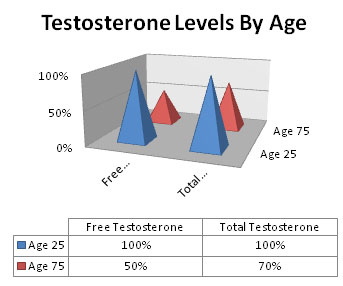Ranges Of Testosterone Levels In Men And Women By Age

Different clinics will have their own numbers of what they consider to be high, low and normal ranges for testosterone levels. This will include different ranges for both men and women depending on their age. It is very easy to see a decline with age in what is considered to be normal as one looks at the numbers on a chart. (See below).
Men will have higher normal testosterone ranges than women, as this hormone is primarily considered a male hormone. However, it is important for women to have it as well. Both genders cannot remain healthy in mind or body without the right amounts of testosterone in their systems.
Low, Normal And High Testosterone Levels In Men And Women
It is always best for both men and women to have their testosterone levels be in the “normal” range and not too low or too high in order for them to feel their very best. Here is a chart that shows what these levels should look like, according to the University of Rochester Medical Center:
Testosterone Level Ranges For Men And For Women
| Men at 30 | Low: < 219 | Total: 219 – 1009 ng/dL | High: > 1009 |
| Men at 40 | Low: < 201 | Total: 201 – 993 ng/dL | High: > 993 |
| Men at 50 | Low: < 170 | Total: 170 – 918 ng/dL | High: > 918 |
| Men at 60 | Low: < 156 | Total: 156 – 700 ng/dL | High: > 700 |
| Women at 30 | Low: < 15 | Total: 15-70 ng/dL | High: > 70 |
| Women at 40 | Low: < 12.75 | Total: 12.75 – 63.75 ng/dL | High: > 63.75 |
| Women at 50 | Low: < 10.8 | Total: 10.8 – 54.19 ng/dL | High: > 54.19 |
| Women at 60 | Low: < 9.21 | Total: 9.21 – 46.06 ng/dL | High: > 46.06 |
- Low, normal and high testosterone levels in men
In order for a man to feel his best physically, mentally, emotionally and sexually, his testosterone levels should fall into the “normal” range for his age. When levels are too low or too high, he could experience negative side effects.
When a man experiences low T, this can be detected in blood work. Doctors will look at a range that is determined by their own research and expertise for their population. What does this mean? Clinics can vary in what they consider low, normal and high ranges. According to the chart above, here is an example:
- A man at age 40 to 50, who has testosterone levels that blood tests show to be 190 ng/dL will be considered to have low levels of testosterone according to the chart above. If his levels were between 201 – 993 ng/dL, they would be considered to be normal levels. If they were 1,000 ng/dL, they would be considered to have high levels.
A man who suffers with low T levels can seek treatment called testosterone replacement therapy (TRT). Injections will need to be prescribed by a licensed doctor after the proper testing and diagnosis have been done. Low T is considered to be a very treatable condition and although symptoms can rob a man from having any quality of life, the issues can be reversed and the person can be happy and healthy once again with the right kind of therapy.
- Low, normal and high testosterone levels in women
Women need less testosterone than men do, but they still need it in order to look and feel their best in every aspect of their health. Their testosterone is created in their ovaries and will slow with age.
If their levels become too low according to the appropriate testosterone blood testing results, they may start to experience symptoms that will stop them from having a happy and healthy life. According to the chart above, here is an example:
- A woman at age 40 to 50, who has testosterone levels that blood tests show to be 10 ng/dL will be considered to have low levels of testosterone according to the chart above. If her levels were between 12.75 – 63.75 ng/dL, they would be considered to be normal levels. If they were 70 ng/dL, they would be considered to have high levels.
Just like for men, women can participate in testosterone replacement therapy to get their levels back up to the “normal” range again. Women will usually not use injections, but patches instead.
Both genders need testosterone and when it gets too low due to the natural process of aging, properly diagnosed low T can be fixed with TRT that is medically supervised to help create safe and effective change.















